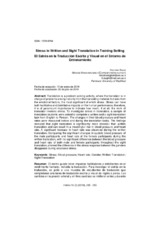Stress in Written and Sight Translation in Training Setting
El Estrés en la Traducción Escrita y Visual en el Entorno de Entrenamiento
Autor
Baghi, Hoorieh
Khoshsaligheh, Masood
Editor
UCOPressFecha
2019Materia
StressBlood pressure
Heart rate
Gender
Written Translation
Sight Translation
Estrés
Presión Arterial
Ritmo cardíaco
Género
Traducción escrita
Traducción visual
METS:
Mostrar el registro METSPREMIS:
Mostrar el registro PREMISMetadatos
Mostrar el registro completo del ítemResumen
Translation is a problem-solving activity, where the translator is in charge of problems arising not only from the translating material, but also from the emotional factors, the most significant of which stress. Stress can have both facilitative and debilitative impacts on the human performance, therefore, it is of paramount importance to indicate how much, if at all, the work of translator involves stress. To investigate stress in translation, a sample of translation students were asked to complete a written and a sight translation task from English to Persian. The changes in their blood pressure and heart rates were measured before and during the translation tasks. The findings revealed that sight translation is significantly more stressful than written translation and can result in a meaningful rise in blood pressure and heart rate. A significant increase in heart rate was observed during the written translation. Comparing the significant changes in systolic blood pressure of the male participants and heart rate of the female participants during the written translation, with no significant difference between the blood pressure and heart rate of both male and female participants throughout the sight translation, showed the difference in the stress response between the genders disappears during excessive stress. El estrés puede tener impactos facilitadores o debilitantes en el rendimiento humano, incluida la traducción. Para investigar el estrés en la traducción, se pidió a una muestra de estudiantes de traducción que completaran una tarea de traducción escrita y visual de inglés a persa. Los cambios en la presión arterial y el ritmo cardíaco se midieron antes y durante las tareas de traducción. Los hallazgos revelaron que la traducción visual es significativamente más estresante que la traducción escrita y puede resultar en un aumento significativo de la presión arterial y el ritmo cardíaco. Se observó un aumento significativo en el ritmo cardíaco durante la traducción escrita. Comparando los cambios significativos en la presión arterial sistólica de los participantes masculinos y el ritmo cardíaco de las participantes femeninas durante la traducción escrita, sin diferencias significativas entre la presión arterial y el ritmo cardíaco de participantes masculinas y femeninas a través de la traducción visual, mostró la diferencia en La respuesta al estrés entre los géneros desaparece durante el estrés excesivo.

